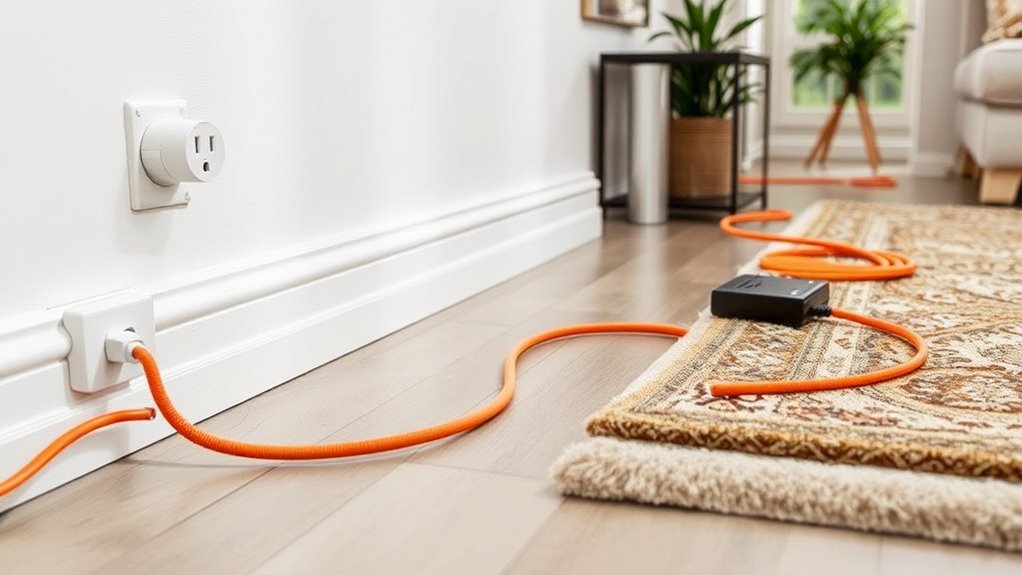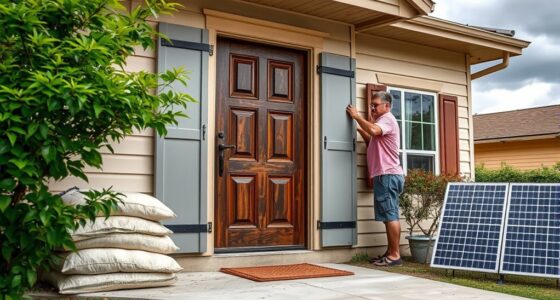To use extension cords safely indoors, choose cords rated for indoor use with appropriate gauge and length, ensuring they match your device’s power needs. Always inspect cords for damage before use and keep them in good condition. Use cords carefully—fully uncoiled, positioned away from water, and away from high-traffic areas to prevent tripping. Avoid overloading, and handle connections properly. Keep damage-prone cords in check, and you’ll improve safety—discover more guidelines to protect yourself and your home.
Key Takeaways
- Select cords rated for indoor use with appropriate gauge and load capacity for your devices.
- Regularly inspect cords for damage such as fraying, cracks, or overheating signs, and replace damaged ones immediately.
- Fully uncoil extension cords before use to prevent overheating and electrical hazards.
- Avoid daisy-chaining multiple cords; use one high-quality cord suited for your power needs.
- Secure cords properly, avoiding excess slack and tripping hazards by taping or using cord covers.
Choosing the Right Extension Cord for Indoor Use

Choosing the right extension cord for indoor use is essential for safety and efficiency. First, consider the cord length. You want a cord long enough to reach your devices comfortably without creating excess slack that can cause tripping hazards or damage. Measure the distance accurately to avoid selecting a cord that’s too short or unnecessarily long. Next, pay attention to material durability. Look for cords made from sturdy, high-quality insulation that withstands daily wear and tear. Durable materials prevent fraying and damage, reducing the risk of electrical hazards. Also, ensure the cord is rated for indoor use, which typically means it has insulation suitable for indoor environments. Selecting a properly sized and durable cord helps keep your space safe and your devices functioning reliably. Additionally, consider the appliance labs standards for cord safety and performance to ensure you are choosing a reliable product. When in doubt, always opt for cords that have undergone testing for fire safety and electrical integrity to minimize potential hazards.
Inspecting and Maintaining Your Extension Cords

You should regularly inspect your extension cords for signs of damage like frayed wires or cracked insulation. To keep them safe, avoid overloading the cords and always follow the manufacturer’s load limits. When not in use, store your cords properly by coiling them neatly and keeping them in a dry, cool place. Incorporating safety practices into your routine can help prevent accidents and extend the lifespan of your cords. Additionally, staying informed about data privacy challenges related to electronic equipment can help you better understand and manage potential risks. Being aware of technological safety standards can also guide you in selecting and maintaining extension cords that meet safety regulations. Regularly checking for air purifier maintenance issues can further ensure your electrical devices operate safely and efficiently.
Check for Damage Regularly
Regularly inspecting your extension cords is essential to guarantee safe indoor use. Look for signs of wear and tear, such as frayed wires or cracked insulation, which can increase the risk of electrical hazards. Also, check for accidental damage like cuts, pinches, or burns that may have occurred from furniture or foot traffic. To keep your cords in top shape, focus on these areas: 1. Examine the plug for bent prongs or looseness. 2. Inspect the cord length for visible splits or exposed wires. 3. Test the entire length for any unusual softness or stiffness indicating internal damage. 4. Be aware of product certifications that verify the safety standards of your extension cords. Regular maintenance can help prevent electrical hazards and ensure your cords perform safely over time. Incorporating proper storage practices when not in use can also reduce the risk of damage and prolong the lifespan of your extension cords.
Avoid Overloading Cords
Inspecting your extension cords for damage is an important step in maintaining safe indoor use. When considering cord length, avoid using excessively long cords, as they can increase the risk of overheating and overloading. Choose cords that match your power needs without unnecessary slack, which can cause tripping hazards. Additionally, pay attention to cord material safety; opt for cords made from high-quality, approved insulation that resists wear and tear. Never connect multiple extension cords together to extend reach, as this can overload the circuit. Always check the cord’s amperage rating and ensure it matches your appliances’ requirements. Proper inspection and mindful selection help prevent overloads, protecting both your devices and your home. Being aware of current home security systems and their effectiveness can also enhance overall safety in your household. Considering the latest tech trends can provide insights into safer, more reliable electrical solutions, especially when choosing extension cords designed with safety features in mind. Staying informed about AI advancements in safety technology can further aid in maintaining a secure environment.
Proper Storage Techniques
Proper storage of your extension cords is essential for maintaining their safety and longevity. When you practice good cord storage, you prevent damage and reduce tripping hazards. Use these organizational tips to keep cords in top shape:
- Coil cords loosely, avoiding tight bends that can damage wires.
- Hang cords on wall hooks or store them in labeled bins to prevent tangling.
- Keep cords away from heat sources, moisture, and direct sunlight to avoid deterioration.
Proper Placement and Positioning of Extension Cords

When placing extension cords indoors, you should guarantee they are positioned to prevent tripping hazards and damage. Proper cord positioning involves laying cords along walls or baseboards rather than across walkways or doorways. Use tape or cord covers to secure loose cords, keeping them flat to avoid curling or fraying. Avoid running cords under rugs or furniture, as this can cause overheating or damage. Ensure cords are not stretched tight between outlets and appliances, allowing some slack for safety. When possible, route cords away from high-traffic areas to minimize accident risk. Safe placement also means avoiding pinching or bending cords sharply, which can weaken insulation. Paying attention to cord durability and placement helps prevent damage and electrical hazards. By paying attention to cord positioning, you reduce the risk of accidents and maintain the integrity of your extension cords.
Avoiding Overloading and Excessive Power Draws

To prevent overheating and electrical hazards, avoiding overloading extension cords with too many devices or high-power appliances is essential. First, consider your cord length; longer cords can increase resistance, which may cause heat buildup if overloaded. Second, pay attention to the cord color—using a heavy-duty, brightly colored extension cord can help you quickly identify high-capacity cords designed for demanding loads. Third, never connect multiple extension cords together, as this can create a tangled web that’s easy to overload unknowingly. Instead, select a cord rated for the total wattage of your devices. Additionally, understanding proper extension cord usage can help you stay informed about best safety practices. Properly managing electrical loads can also prevent fire hazards and ensure safe, reliable power delivery indoors. Being aware of extension cord ratings and their specifications can further help you choose the right cord for your needs. By monitoring these factors—cord length, color, and load—you reduce the risk of overheating and guarantee safe, reliable power delivery indoors.
Safe Handling and Connection Techniques

Handling and connecting extension cords correctly is essential for safety. Proper connection techniques prevent accidents and ensure reliable power. Always uncoil cords fully to avoid overheating and damage. When plugging in, hold the plug, not the cord, to prevent stress on connections. Keep cords away from water, heat, and sharp objects. Using the correct suction power and cleaning modes can also help prevent electrical issues in appliances. Additionally, understanding how automation’s role in business intelligence contributes to safer and more efficient use of electrical devices can inform better safety practices.
Using Extension Cords With High-Power Appliances

Using extension cords with high-power appliances requires extra caution to prevent overheating and electrical hazards. These appliances have high power ratings, which can strain cords if not used properly. To guarantee safety, keep these tips in mind:
- Check the power ratings of both the appliance and extension cord to confirm compatibility.
- Avoid daisy-chaining multiple cords, which can overload the circuit.
- Use heavy-duty extension cords designed for high-power appliances, and never plug a large device into a thin, lightweight cord.
Minimizing Risks of Tripping and Damage

Since extension cords can create tripping hazards and risk damage to both the cord and surrounding objects, it’s essential to place them carefully and manage their placement. Consider cord length to avoid excess slack that can cause tripping or get caught on furniture. Keep cords taut and secure, avoiding tight bends that may damage the wire. Use color coding practices—such as bright or contrasting colors—to easily identify cords and prevent accidental trips or pinching. When running cords across floors, tape them down securely or use cord covers to prevent movement. Regularly check for signs of wear or damage, and reposition cords to minimize foot traffic over vulnerable areas. Proper management reduces hazards, protects your cords, and maintains a safe indoor environment.
Recognizing and Addressing Signs of Wear and Damage

You should regularly inspect your extension cord for signs of wear, like frayed or cracked insulation. Notice if it’s not performing as smoothly or if devices connected to it seem to have reduced power. Addressing these issues early keeps you safe and prevents potential hazards.
Visual Damage Indicators
How can you tell if an extension cord is safe to use? Look for visual damage indicators like cord discoloration, which signals overheating or aging. Check for any visible cuts, cracks, or frayed wiring that compromise safety. Specifically, pay attention to these signs:
- Discoloration or scorch marks on the cable, indicating overheating.
- Exposed or frayed wires that may cause short circuits.
- Damaged insulation with cracks or splits exposing internal conductors.
These visual damage signs suggest the cord may no longer be safe. If you notice any of these, stop using the extension cord immediately. Addressing visual damage early helps prevent electrical hazards and potential fires, ensuring your indoor safety.
Functional Performance Changes
Visual damage is an important warning sign, but changes in how your extension cord performs can also reveal underlying issues. If you notice performance degradation, such as flickering lights or intermittent power, it’s a sign that the cord’s functionality loss is occurring. You might feel a warm or hot cable during use, indicating internal damage or poor connections. Reduced power delivery can cause appliances to operate inefficiently or even malfunction. Pay attention to any unusual resistance or difficulty when plugging in devices. These performance changes often signal internal wear or damage that isn’t visible externally. Addressing these issues promptly helps prevent electrical hazards and ensures your extension cord continues to function safely indoors. Regularly assess both visual and performance indicators for safe use.
Alternative Power Solutions for Permanent Needs

When a need for a reliable, long-term power source arises indoors, investing in dedicated solutions is the safest choice. Proper cord management and indoor wiring guarantee safety and efficiency. Consider these options:
- Fixed wiring: Professionally installed circuits eliminate the hazards of extension cords, providing a clean, safe power source.
- Built-in outlets: Adding outlets where needed reduces clutter and minimizes tripping hazards.
- Power strips with surge protection: For areas needing multiple devices, these protect your electronics and organize cords neatly.
These solutions help prevent overloads, reduce clutter, and keep cords safely managed. They’re ideal for permanent setups, offering a safer alternative to extension cords while supporting your power needs efficiently.
Frequently Asked Questions
Can Outdoor Extension Cords Be Safely Used Indoors?
You might wonder if outdoor extension cords are safe indoors. While they’re designed for outdoor weatherproofing and can handle moisture and rough conditions, they often don’t meet indoor electrical safety standards. Using them inside can increase fire risks or electrical shocks. Always check labels, and stick to cords rated for indoor use to guarantee safety. When in doubt, consult an electrician for proper extension cord selection and use.
How Long Can an Extension Cord Be Safely Used Indoors?
Your extension cord can be safely used indoors up to about 50 feet, but that’s a marathon, not a sprint. To guarantee safety, consider wire gauge considerations—thicker wires (like 16-gauge) handle more current and go farther safely. Always follow cord storage tips; avoid tangling and damage. Longer cords increase risk of voltage drop, so keep it as short as possible and inspect regularly for wear and tear.
Are There Specific Safety Certifications to Look for on Cords?
When choosing an extension cord, you should look for safety certifications on the cord labeling. Certifications like UL (Underwriters Laboratories) or ETL guarantee the cord meets safety standards. These labels indicate the cord has been tested for safety and quality. Always verify the safety certifications before purchasing or using an extension cord indoors, as they help prevent electrical hazards and ensure reliable performance.
What Should I Do if an Extension Cord Overheats?
An extension cord overheating is like a firework about to explode—dangerous and urgent. If you notice it overheating, immediately unplug it to prevent a potential fire. Follow safety precautions by avoiding daisy-chaining cords, not overloading outlets, and checking for damage. Never ignore signs of overheating, as it can cause serious injuries or property damage. Stay alert, act quickly, and prioritize safety to keep your space secure.
How Do I Dispose of Damaged Extension Cords Safely?
When your extension cord is damaged, proper disposal is essential for safety and environmental reasons. You should first cut off the plug and remove any damaged parts. Then, check local recycling options for electronics or electrical waste, as many communities offer special disposal or recycling programs. Avoid throwing it in the trash to prevent hazards and promote eco-friendly recycling options, ensuring the cord’s materials are safely processed.
Conclusion
By paying close attention to proper extension cord practices, you can create a safer indoor environment that respects both your needs and the subtle dance of everyday life. When you choose wisely, handle gently, and stay attentive to signs of wear, you’re gently guiding your space toward harmony. Remember, gentle precautions today help you avoid unwelcome surprises tomorrow—allowing your home to remain a sanctuary of comfort and peace, quietly protected and thoughtfully maintained.









